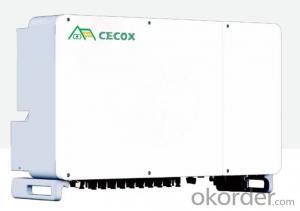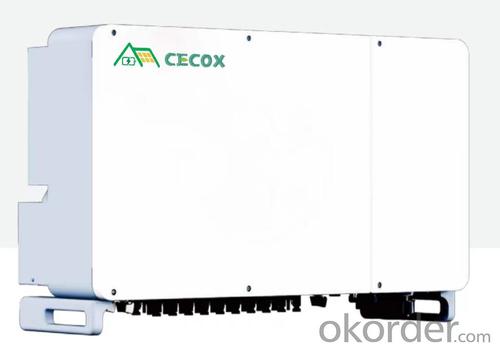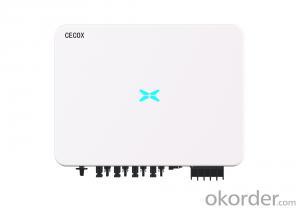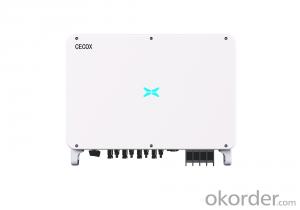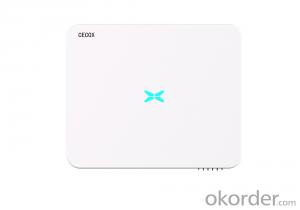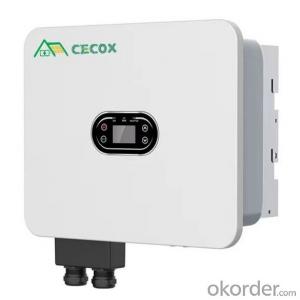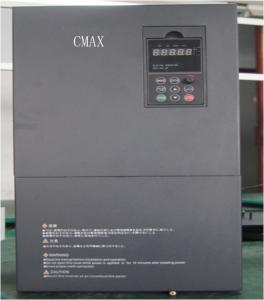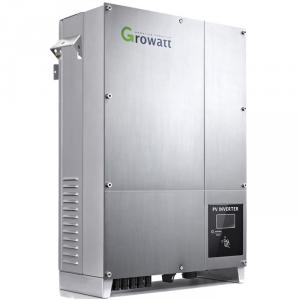100-136kW Three Phase On-Grid Solar Inverter Package
- Loading Port:
- China main port
- Payment Terms:
- TT OR LC
- Min Order Qty:
- 1 unit
- Supply Capability:
- 50 unit/month
OKorder Service Pledge
OKorder Financial Service
You Might Also Like
Specification
Efficient power generation, higher returns
9-12 MPPT, single tracking accuracy is high, dynamic response speed is fast, higher power generation
1.5x DC supermatch
Maximum efficiency %, wide voltage range (180-1000V), early start and late stop, more durable power generation
Suitable for high current components
Intelligent protection operation and maintenance is simple
Intelligent IV diagnosis can accurately locate string faults and proactively find problems
Support fault recording, real-time observation and recording of inverter AC voltage and current waveform, quickly locate problems
Support RS485 (WiFi/DRM/ Bluetooth optional), mobile phone/computer intelligent monitoring, anytime and anywhere more convenient operation
Safe and reliable, comprehensive Warranty
IP66 high protection, support outdoor installation
AC-DC secondary lightning protection, actively eliminate lightning hazards
DC arc detection (AFCI) function is optional, accurately distinguish arc signal, fast shutdown, avoid fire
IEC/EN 62109-1/2, IEC/EN 61000-6-1/3, IEC/EN 61000-6-2/4, EN50549, IEC61727/IEC62116, CEI 0-21/CEI 0-16, C10/C11, VDE 4105, VDE 0124, G99, RD244, UNE217001, UNE217002, NC RfG, TOR Erzeuger, NRS097-2-1, NB/T 32004
Night power consumption <1W
Size:1050 x 660 x 330 mm
Weight:95/98/101kg(100KW/110KW/136KW)
Quality Warranty:5-10 years
- Q: Can a solar inverter be used with a solar-powered air cooling system?
- Yes, a solar inverter can be used with a solar-powered air cooling system. The solar inverter would convert the direct current (DC) electricity produced by the solar panels into alternating current (AC) electricity, which can then be used to power the air cooling system. This allows the system to operate efficiently and effectively using solar energy.
- Q: Are there any electromagnetic interference concerns associated with solar inverters?
- Yes, there can be electromagnetic interference concerns associated with solar inverters. These concerns mainly arise from the high-frequency switching of power electronics within the inverters. However, modern solar inverters are designed to minimize electromagnetic interference through the use of appropriate filters and shielding techniques. Compliance with relevant electromagnetic compatibility (EMC) standards ensures that solar inverters do not interfere with other electronic devices and are safe to use in residential and commercial settings.
- Q: What is the importance of overcurrent protection in a solar inverter?
- The importance of overcurrent protection in a solar inverter is to ensure the safety and longevity of the system. Overcurrent protection helps prevent damage to the inverter and other components by interrupting the flow of excessive current. It safeguards against potential hazards such as overheating, electrical fires, and equipment failures. Additionally, overcurrent protection helps maintain the efficiency and performance of the solar inverter, ensuring optimal power generation and system reliability.
- Q: Can a solar inverter be used in areas with high altitude and low temperature conditions?
- Yes, a solar inverter can be used in areas with high altitude and low temperature conditions. However, it is important to choose a solar inverter specifically designed for such conditions, as extreme cold temperatures and high altitudes can affect the performance and efficiency of standard inverters. Specialized inverters that can withstand low temperatures and operate at high altitudes are available in the market to ensure optimal functioning of solar power systems in such environments.
- Q: What is the role of voltage regulation in a solar inverter?
- The role of voltage regulation in a solar inverter is to ensure that the output voltage of the inverter remains stable and within a certain range, regardless of fluctuations in the input voltage from the solar panels. This is important as it allows the inverter to effectively convert the DC power generated by the solar panels into AC power that can be used by household appliances or fed back into the grid. Voltage regulation helps protect the connected devices from voltage spikes or drops, optimizes the performance of the inverter, and ensures the safe and efficient operation of the entire solar power system.
- Q: How does a solar inverter impact the overall system reliability?
- A solar inverter plays a crucial role in ensuring the overall system reliability of a solar power system. It converts the direct current (DC) generated by solar panels into alternating current (AC) that is suitable for use in homes or businesses. By efficiently converting the energy and maintaining optimal voltage and frequency levels, the inverter ensures that the system operates reliably and consistently. It also provides various protective functions, such as monitoring and controlling the system's performance, detecting faults or abnormalities, and shutting down the system in case of emergencies. Therefore, a well-functioning solar inverter significantly impacts the overall system reliability by maximizing energy production, preventing damage, and ensuring smooth operation.
- Q: Can a solar inverter be used with solar-powered remote sensing systems?
- Yes, a solar inverter can be used with solar-powered remote sensing systems. A solar inverter is responsible for converting the direct current (DC) produced by solar panels into alternating current (AC) that can be used to power electrical devices. In the case of solar-powered remote sensing systems, the solar inverter plays a crucial role in converting the DC power generated by the solar panels into AC power to operate the sensing equipment. This ensures the efficient utilization of solar energy in powering remote sensing systems.
- Q: Can a solar inverter be used in systems with multiple inverters?
- Yes, a solar inverter can be used in systems with multiple inverters. In fact, using multiple inverters is a common practice in larger solar power systems. Each inverter is connected to a separate set of solar panels, and they work together to convert the DC power generated by the panels into AC power that can be used in homes or businesses. Multiple inverters allow for increased power output and better system efficiency.
- Q: What is the role of a solar inverter in a grid-tied system?
- The role of a solar inverter in a grid-tied system is to convert the direct current (DC) electricity produced by the solar panels into alternating current (AC) electricity that can be used by the electrical grid or consumed by the appliances and devices in a home or business. It also ensures that the solar energy generated is synchronized with the grid's voltage and frequency to enable efficient and safe transfer of power. Additionally, the solar inverter monitors and controls the flow of electricity between the solar panels, the grid, and any energy storage systems that may be connected to the system.
- Q: How do you size a solar inverter for a solar power system?
- To size a solar inverter for a solar power system, you need to consider the maximum power output of the solar panels and the total load you want to power. The inverter's capacity should be equal to or greater than the total power output of the solar panels to ensure efficient energy conversion. Additionally, you should also consider the voltage and current requirements of the load to ensure compatibility with the inverter. It is recommended to consult with a professional or use online sizing tools to accurately determine the appropriate inverter size for your specific solar power system.
Send your message to us
100-136kW Three Phase On-Grid Solar Inverter Package
- Loading Port:
- China main port
- Payment Terms:
- TT OR LC
- Min Order Qty:
- 1 unit
- Supply Capability:
- 50 unit/month
OKorder Service Pledge
OKorder Financial Service
Similar products
Hot products
Hot Searches
Related keywords
